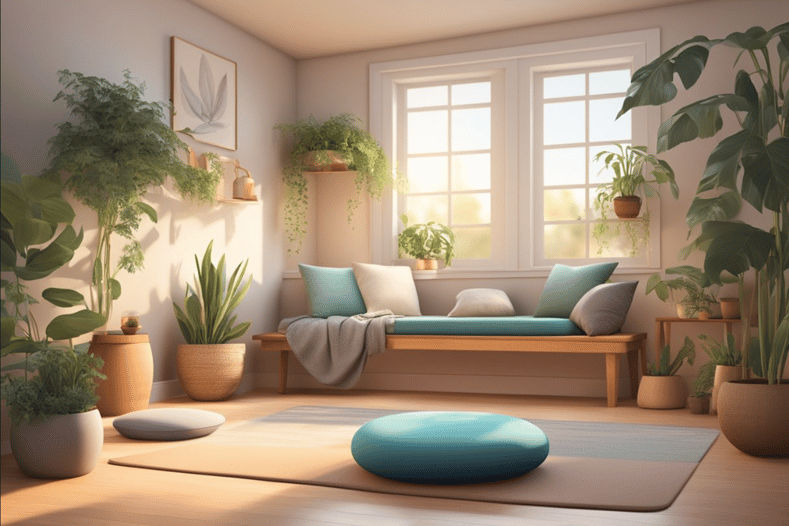
How to Set Up a Home Meditation and Yoga Space (Must-Have Essentials for Mindful Practice)
Create a calming sanctuary for your meditation and yoga practice right at home. This guide covers everything you need — from choosing the ideal quiet space to essential gear like yoga mats, meditation cushions, blocks, bolsters, and soothing aromatherapy tools. Learn how to design a peaceful environment that supports mindfulness, breath work, and daily movement with ease. Whether you're setting up in a corner or a dedicated room, find simple ways to turn your space into a haven for focus, relaxation, and strength.
4 min read
How to Set Up a Home Meditation and Yoga Space Must-Have Essentials for a Peaceful Practice
Creating a dedicated space for meditation and yoga at home can improve focus, relaxation, and consistency in practice. A successful setup requires selecting quiet, clutter-free areas, comfortable mats or cushions, and soothing elements like natural light or gentle lighting. These essentials support both physical comfort and mental calm.
They should also consider adding personal touches such as plants, calming scents, or minimal decor to enhance the environment. The goal is to design a space that invites regular use and fosters mindfulness without distractions.
By focusing on these key elements, anyone can create a practical and inviting home area for meditation and yoga, suited to their individual needs and available space.
Choosing the Ideal Space. A home meditation and yoga space should support focus, comfort, and relaxation. Key factors include noise control, natural light availability, and airflow. These elements create an environment conducive to mindfulness and physical practice.
Selecting a Quiet Location. Choosing a quiet area reduces distractions and supports concentration. Spaces away from household noise such as TVs, kitchens, or busy corridors work best. Bedrooms, spare rooms, or corners with doors that can close are ideal.
If quiet is limited, consider soundproofing options like rugs, curtains, or acoustic panels. Using a white noise machine or soft music can also mask external sounds. Ensure any electronic devices nearby are silenced or turned off to maintain calm.
Maximizing Natural Light.Natural light boosts mood and wakefulness during practice. A bright corner or room with large windows is preferred. South or east-facing windows usually provide consistent, soft light.
Use sheer curtains or blinds to diffuse harsh sunlight. Avoid direct glare that can strain the eyes. If natural light is insufficient, supplement with warm, adjustable artificial lighting like salt lamps or dimmable LEDs.
Ensuring Adequate Ventilation. Fresh air circulation prevents stuffiness and keeps the practitioner alert. Choose a space with windows that can open or access to a ventilation system.
If outdoors isn’t an option, a fan or air purifier helps maintain airflow. Avoid spaces prone to dampness or odors, as these can interrupt focus and comfort. Clean, fresh air supports breathing techniques and overall well-being during sessions.
Must-Have Essentials for Meditation and Yoga. A successful home meditation and yoga setup prioritizes comfort, support, and ambiance. Choosing the right equipment promotes proper alignment and enhances relaxation. Specific items target different needs in practice, from physical support to creating a calming atmosphere.
Yoga Mats and Meditation Cushions. Yoga mats must provide adequate grip and cushioning to protect joints during poses. Materials like natural rubber or TPE are preferred for durability and eco-friendliness. Thickness typically ranges from 4mm to 6mm for balance between support and portability.
Meditation cushions help maintain proper posture by elevating the hips above the knees. Common types include zafus—round cushions that encourage upright seating—and zabutons, which add floor cushioning. The right cushion reduces strain on the lower back and hips, aiding longer sit times.
Supportive Props: Blocks, Bolsters, and Straps. Blocks offer stable support for reaching the floor or maintaining balance in poses. They are usually made from cork or foam and come in standard dimensions of approximately 9” x 6” x 4”.
Bolsters provide full-body support in restorative yoga and help open the chest or hips. Rectangular or cylindrical shapes fill gaps between the floor and body, easing tension during extended holds.
Straps assist in stretching tight muscles by extending reach. Nylon or cotton straps typically have adjustable loops or buckle fasteners, making them versatile for many poses.
Comfortable Seating Options: Comfortable seating is essential for meditation beyond cushions. Chairs with firm support and straight backs prevent slouching. Floor stools and kneeling benches also encourage proper alignment by tilting the pelvis forward.
The choice of seat depends on individual flexibility and comfort. It is beneficial to experiment with various options to find what best supports prolonged stillness without discomfort.
Aromatherapy and Diffusers: Aromatherapy enhances relaxation by delivering calming scents like lavender, sandalwood, or eucalyptus. Essential oil diffusers use water and ultrasonic waves to disperse fragrance evenly through the space.
Choosing a diffuser with adjustable mist and timer settings allows control over scent intensity and duration. Using natural oils free of synthetic additives ensures a safe and soothing environment.
Creating a Calming Environment: Creating a home meditation and yoga space requires attention to elements that promote peace and focus. Choosing natural accents, personal touches, and appropriate lighting plays a vital role in fostering a soothing atmosphere.
Incorporating Plants and Greenery: Plants improve air quality and add life to a meditation or yoga area. Low-maintenance options like snake plants, pothos, or succulents are ideal. They do not require frequent care and thrive indoors.
Adding greenery encourages a connection to nature, which can reduce stress. Position plants near windows for natural light or use grow lights if natural sunlight is limited. Grouping plants in varying heights creates visual interest without clutter.
Decor and Personal Touches: Simple decor contributes to mental clarity. Use neutral or soft color palettes that don't distract during practice. Textured items like cushions, throws, or small rugs add comfort and warmth.
Personal items such as meaningful artwork, small statues, or crystals can enhance the space. These should evoke calm and inspiration without creating visual noise. It’s important to keep the area uncluttered for easy movement and relaxation.
Lighting Choices for Relaxation: Soft, adjustable lighting is essential in a meditation and yoga space. Warm white bulbs or Himalayan salt lamps offer gentle illumination that avoids harsh glare. Dimmable lights provide control over brightness.
Natural light is preferable but should be filtered with sheer curtains to prevent direct sun. Candles or LED tealights can be used for a calming effect during quiet sessions, but they should be placed safely away from flammable materials.
Maintaining Your Home Meditation and Yoga Space: A well-maintained space supports consistent practice and mental clarity. Consistent organization and cleanliness are key. Attention to these details helps preserve the room’s calming atmosphere and functional purpose.
Regular Cleaning and Care: Regular dusting and vacuuming prevent dust buildup on mats and floor surfaces. Using non-toxic, gentle cleaners on mats and wood enhances longevity without damaging materials. Allowing mats and cushions to air out daily reduces odor and moisture.
Checking equipment for wear and tear ensures safety and comfort during sessions. Replacing worn mats or props maintains a professional and pleasant environment.


